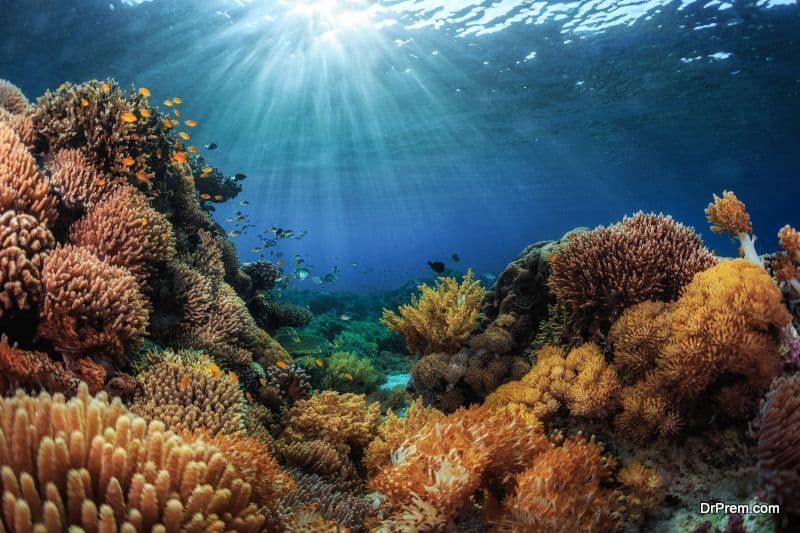1. Vegetation Dieback in Amazonia
Amazon, the monstrously large and an important planetary eco-system is more than just a forest. Described as the “Lung of the Planet”, the Amazon is a major carbon storage reserve. It is home to more than half of the world’s estimated 10 million species of plants, animals and insects. One-fifth of the world’s fresh water is in the Amazon Basin. According to WWF, climate change and deforestation now threaten to wipe out nearly 60% of the Amazon forests by 2030. This is destined to spell doom for our planet’s eco system. Through constant logging and slash and burn methods this CO2 repository will be turned into CO2 emitter releasing carbon into the atmosphere contributing to further global warming. Resultant decline in rainfall has already led to severe droughts in a decade. The twin threats of deforestation and greenhouses gases could reduce the rainfall by up to 50 cms and rise in temperatures up to 7 degrees higher than today, will kill off vast areas of what is now lush tropical forest, the world’s richest wildlife habitat, endangering several exotic species and turn it into grassland or even desert. It would be disastrous for millions of people who have inhabited the Amazon over centuries and for the world climate.
2. Loss of coastal wetland, Eastern Unites States
Thanks to large number of people living along coastal wetlands, the US has lost 59,000 acres of vital wetland each year from 1998-2004. More than half of US population lives in coastal counties with densities five times greater than inland counties. Mississippi river delta is a subtropical landscape of wetlands and low land barrier islands fast getting eroded by construction of roads, homes, and canals cut through wetlands to access oil and gas. In the times to come heavier rainfall will erode the amount of salt in marshes killing the plants that live in salt water and turning the marshes into mud flats prone to erosion. More so, rise in sea level and increasing frequency of storms and hurricanes will reduce the barrier significantly making lowland Louisiana including the city of New Orleans, susceptible to devastating floods besides threatening, fisheries, oil and gas reserves that serve the entire nation. Already Louisiana is losing marshlands equivalent to the size of a football field every 40 minutes.
3. Manmade emissions and the Great Barrier Reef
The Great Barrier Reef structure is composed of and built by billions of tiny organisms, known as coral polyps. Coral reefs are the most vital indicator to the rise in ocean temperatures. The reef which supports a wide diversity of life comprising vast types of rare and endangered species faces most significant threat due to climate change, rise in ocean temperatures, salinity, acidity and other environmental factors that have led to mass coral bleaching. 16% of the coral reefs have been lost in the last 5 years with 27% left seriously endangered across the world. Rise in temperature by just 1 degree or more and the reefs begin to die. This could affect the temperature and habitat of various species that thrive on the coral reefs besides putting hundreds of billions of dollars worth related tourist industry at risk. Without immediate attention and swift remedy, the various reefs around the world will not survive the century.
4. Three Gorges Dam, China
Hailed as one of the engineering feats of the 20th century, the Three Gorges Dam across China’s mighty Yangtze River now threatens to become an environmental catastrophe. For more than a decade China has promoted the world’s biggest hydro-electric project as the best way to end centuries of floods along the basin of the Yangtze and to provide energy to fuel the country’s economic boom. The dam which had already displaced 1.3 million people threatens to displace many more. Studies by geologists have shown that the water seeping out of the reservoir and the huge pressure changes are weakening the banks. The shore of the reservoir has collapsed in several places. Landslides have produced waves as high as 50 m (165ft). A few years back an entire mountain along a tributary collapsed, dragging 13 farmers to their deaths and drowning 11 fishermen. Aquatic life has been destroyed.
Above everything else the government too recognizes the ecological and environmental deterioration that could lead to catastrophic consequences if no preventive measures were taken.
5. Colony Collapse Disorder
In what has been termed as the potential AIDS for the bee industry bees are dying in Germany and USA. Bee colonies have 25% in Germany whereas in some places colonies have decreased by 80%. The world’s pollinating bee army is dwindling sharply in what many call as the colony collapse disorder. Scientists believe that large scale use of genetically modified plants may have caused this disorder.
A bacterial toxin in genetically modified corn used within US weakens the immune system making the bees succumb and as a result die by contracting different types of infections and fungi. The crisis has the potential to have devastating consequences for the beekeeping industry. The bees are a vital agent in pollinating plants in fact 1/3rd of man’s food supply would not exist without some type of insect pollination. Their absence could lead to drastic drop down in the levels of food production and threaten the food we eat.


